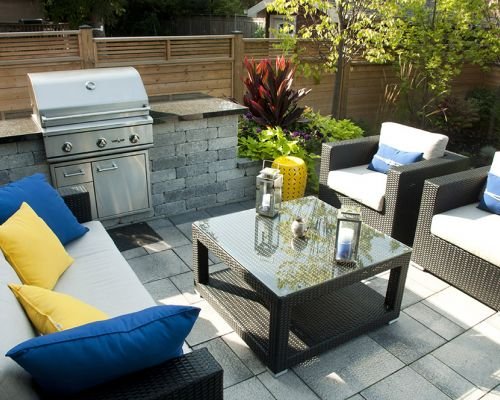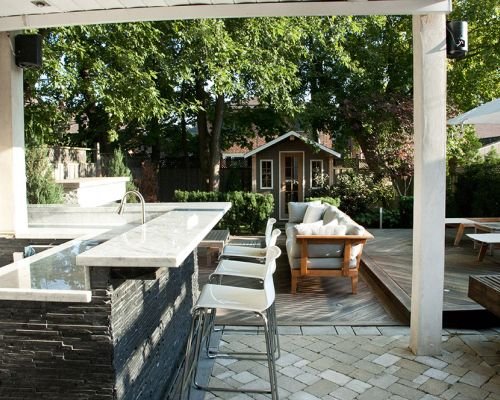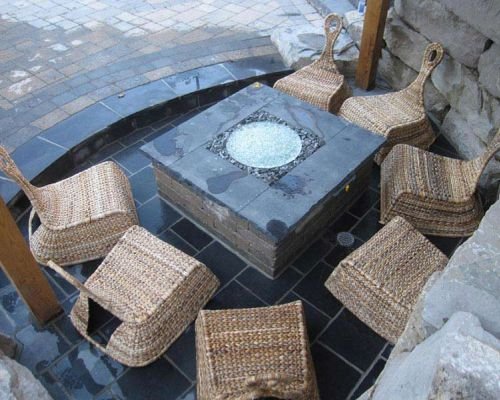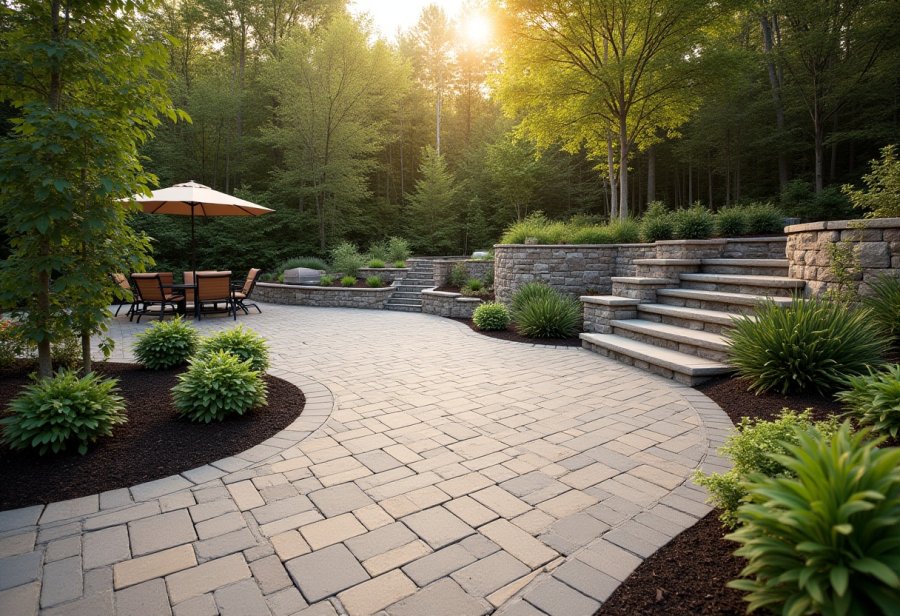Transforming Toronto yards into stunning outdoor retreats requires a delicate balance of beauty, sustainability, and client satisfaction. How can homeowners achieve landscapes that are not only visually captivating but also eco-friendly and resilient to Toronto’s seasonal extremes? This guide explores innovative strategies, from native plantings and water-saving features to eco-conscious materials and smart technology, all tailored to the city’s unique climate and cultural diversity. Real-world case studies illustrate how thoughtful design transforms neglected spaces into vibrant havens for relaxation and entertainment. Expert insights emphasize the importance of collaborative planning, sustainable practices, and future-forward trends like renewable energy integration and biodiversity promotion. As outdoor design evolves, the question remains: How can we create personalized, environmentally responsible landscapes that thrive for years and elevate urban living? This comprehensive overview invites homeowners and professionals alike to reimagine outdoor spaces as sustainable sanctuaries that blend aesthetics with practicality.
Transform Your Toronto Outdoor Space with a Stunning Backyard Makeover
Looking to revamp your outdoor area in Toronto? Toronto Landscape & Design (TLD) offers exceptional services including natural stone installations, water gardens, irrigation systems, and retaining walls. Our award-winning designers take everything into consideration to create personalized, beautiful, and functional landscapes that enhance your property’s curb appeal. Whether you’re dreaming of a serene water feature or durable retaining walls, TLD is your go-to team for a comprehensive backyard makeover. Contact us today at 1.416.644.0499 or email mike@torontolandscapedesign.com to discuss your project and bring your outdoor vision to life.

Transforming Toronto Yards into Sustainable Outdoor Retreats
Transforming outdoor spaces in Toronto isn’t just about boosting curb appeal; it’s about creating environments that are both beautiful and sustainable. As residents become more aware of environmental challenges and climate shifts, the focus has shifted toward landscapes that combine visual charm with eco-friendly practices. A well-designed yard should serve as a peaceful retreat, supporting local ecosystems, conserving resources, and enhancing daily life.
Toronto’s varied climate, with its four distinct seasons, demands thoughtful planning. Native plants that naturally thrive here reduce water use and chemical reliance, making landscapes more resilient and easier to maintain over time. Incorporating water-saving features such as rain gardens and permeable surfaces not only manages stormwater effectively but also supports the health of local waterways. These strategies help build outdoor spaces that are as practical as they are attractive.
The city’s unique geography along the Great Lakes offers additional opportunities for creative design. Water features, natural terrain, and microclimates can be woven into yard plans to add visual interest and foster a deeper connection with nature. Toronto’s rich cultural diversity also influences landscape styles, blending traditional and contemporary elements to reflect the vibrant community. Each transformation becomes a personalized expression of the owner’s style and values.
Creating an outdoor space that’s both appealing and functional requires more than aesthetics. It involves selecting durable, eco-conscious materials and designing layouts that stand the test of time. From recycled furnishings to permeable paving, these choices minimize ecological impact while enhancing the yard’s visual appeal. Native plantings further contribute to resilience, ensuring the landscape remains vibrant through Toronto’s seasonal changes.
Effective communication between homeowners and landscape professionals plays a vital role. Understanding client preferences and lifestyle needs guides the entire process, from initial concept sketches to final installation. Visual tools like digital renderings help homeowners envision their spaces, fostering collaboration and confidence. This partnership ensures the finished yard aligns perfectly with the owner’s vision while meeting sustainability goals.
Ultimately, transforming Toronto yards into stunning, sustainable retreats is about more than just aesthetics. It’s a delicate balance of beauty, practicality, and environmental responsibility. Thoughtful design, native plant selection, and eco-conscious choices come together to produce outdoor spaces that thrive year after year. These transformations not only elevate property value but also contribute to a healthier, more sustainable city—and that’s a goal worth every effort.
Fundamental Design Principles for Harmonious and Functional Outdoor Spaces
Creating an outdoor space that feels balanced and inviting starts with core principles like harmony, functionality, and visual appeal. Harmony ensures that plants, hardscapes, and features work together seamlessly, creating a cohesive look that feels natural rather than staged. When every element complements the others, the yard becomes a place that encourages relaxation and exploration, avoiding a cluttered or disjointed feel.
Functionality is just as vital as beauty. A well-designed yard should serve the needs of its users—be it for outdoor dining, play, or quiet reflection. Thoughtful zoning helps maximize the space, creating designated areas for seating, gardening, or entertainment. Smooth pathways and transitions guide visitors effortlessly from one zone to another, making the yard both practical and inviting. When beauty and utility go hand in hand, the space becomes more than just visually appealing—it transforms into a usable retreat.
Visual appeal hinges on creating focal points and selecting a thoughtful color palette. Water features, sculptures, or standout plants serve as eye-catching anchors that add depth and interest. Seasonal color changes—vibrant blooms or lush greenery—help set the mood and keep the space lively year-round. Good lighting further enhances these elements, highlighting key features and extending usability into the evening hours, making the yard welcoming both day and night.
Incorporating native plants is a smart move to maintain harmony with Toronto’s climate. These species are naturally adapted, requiring less water, fewer chemicals, and minimal maintenance. They also support local ecosystems by attracting pollinators and wildlife, turning the yard into an ecological haven. Pairing native flora with eco-friendly materials—like permeable pavers or recycled furnishings—further elevates sustainability while maintaining aesthetic appeal.
Understanding client preferences is essential to creating a yard that truly reflects personal style and lifestyle. Open dialogue, sketches, and digital renderings facilitate collaboration, allowing homeowners to visualize options and make informed adjustments. This process ensures the final design aligns perfectly with their needs and aesthetic goals, resulting in a space that feels personalized and satisfying.
Finally, innovative features like smart lighting, fire pits, or water elements can elevate a backyard from simply beautiful to truly engaging. When integrated thoughtfully, these additions create ambiance and functionality, encouraging outdoor enjoyment at any time. Balancing these principles—harmony, utility, and visual interest—lays the foundation for outdoor spaces that are not only stunning but also resilient and easy to maintain for years to come.

Real-World Success Stories: Implementing Design Strategies in Toronto
Transforming Toronto yards into stunning outdoor retreats is best understood through real-world examples that bring design principles to life. One project turned a neglected, weed-filled backyard into a cozy outdoor living space by emphasizing native plantings and installing a permeable patio. This approach not only boosted visual appeal but also reduced maintenance, creating a resilient yard that blends naturally with its surroundings. The result is a peaceful retreat perfect for relaxing evenings and intimate gatherings.
In another example, adding a modern fire pit and a water feature created an inviting atmosphere that encourages outdoor entertaining. These focal points were carefully integrated with native plants and eco-friendly materials, elevating the overall design. The fire pit provides warmth and ambiance for evening chats, while the water element adds soothing sounds, making the space both functional and calming. Such features demonstrate how thoughtful use of sustainable elements can enhance both aesthetics and usability.
Several projects highlight the importance of selecting native plants suited to Toronto’s climate. These plants thrive naturally, requiring less water, fewer chemicals, and minimal upkeep over time. Pairing them with sustainable hardscapes like recycled stone and permeable pavers manages stormwater effectively and reduces ecological impact—all while maintaining visual interest. When combined, these strategies create landscapes that are both beautiful and resilient, capable of withstanding seasonal extremes.
One yard was transformed from an overgrown, uninviting space into a lively area designed for both relaxation and socializing. Native plants were paired with a rain-absorbing stone patio, and soft lighting was added to create an inviting atmosphere after sunset. This shows how careful material choices and plant selections support long-term durability, even in Toronto’s variable weather. The result is a versatile outdoor space that encourages frequent use and enjoyment.
Innovation plays a key role in these successful transformations. Smart lighting, solar-powered features, and modular hardscape materials allow homeowners to extend usability into the evening and easily update their outdoor spaces. These modern touches make the yard more functional and environmentally friendly, inspiring residents to spend more time outside while minimizing resource use. Each project underscores how blending traditional design principles with current technology leads to sustainable, enjoyable outdoor retreats.
Every yard presents unique challenges, from underground utilities to harsh winters. Effective projects involve flexible planning and resilient plant choices to ensure landscapes remain beautiful and functional over time. Close collaboration between homeowners and professionals helps navigate these obstacles, resulting in outdoor spaces that stand up to Toronto’s climate and meet individual needs. These real-world examples prove that thoughtful application of design principles can turn any backyard into a personalized, sustainable sanctuary.
For those interested in further enhancing their outdoor spaces, exploring innovative design strategies can provide additional inspiration. Incorporating sustainable materials and native plant selections not only improves resilience but also creates a harmonious environment. To learn more about how to implement these ideas effectively, you can visit Toronto Landscaping Experts for professional guidance and creative solutions.
Expert Insights and Best Practices for Creating Resilient Landscapes
Toronto landscape professionals bring a wealth of expertise to transforming yards into stunning, sustainable outdoor retreats. Their first step is always a thorough assessment of each site—analyzing soil quality, drainage patterns, and existing vegetation. This careful evaluation helps inform smarter, more resilient design choices that can withstand Toronto’s seasonal extremes, preventing common pitfalls and setting the stage for long-lasting landscapes.
A key practice among these experts is prioritizing native plants. These species are naturally adapted to Toronto’s climate, requiring less water, fewer chemicals, and minimal maintenance. Beyond their practicality, native plants support local ecosystems by attracting pollinators and wildlife, turning yards into ecological havens. By integrating native flora, landscape professionals create landscapes that are both beautiful and environmentally responsible, aligning with the broader goal of sustainability.
Clear communication with clients forms the backbone of successful projects. Professionals emphasize involving homeowners early in the process—using sketches, digital renderings, and visual tools to help clients visualize options and make informed choices. This collaborative approach ensures the final design genuinely reflects individual lifestyles, aesthetic preferences, and practical needs, fostering a sense of ownership and confidence in the project.
Sustainable materials also play a crucial role. Reclaimed stone, recycled wood, permeable pavers, and eco-friendly hardscapes reduce environmental impacts while adding distinctive character. Combined with water-efficient practices like rain gardens and drip irrigation, these choices create low-maintenance, resilient landscapes that thrive with minimal intervention. When integrated thoughtfully, such materials and techniques enhance both the sustainability and visual appeal of outdoor spaces.
Staying current with emerging innovations keeps these professionals at the forefront of the industry. Many incorporate smart irrigation systems that adjust watering based on weather conditions, conserving water and reducing costs. Modern outdoor lighting—solar-powered fixtures and LED systems—not only enhances aesthetics but also improves safety and usability after dark. These tech-driven solutions make outdoor spaces more functional and eco-conscious, encouraging homeowners to enjoy their yards year-round.
Effective project management ensures ideas turn into reality smoothly. Experienced landscapers coordinate closely with contractors and suppliers, maintaining clear timelines and quality standards. Regular site visits and updates help identify issues early, preventing delays and cost overruns. This professional oversight guarantees that every yard transformation meets both aesthetic and environmental goals, leaving homeowners with outdoor retreats they can enjoy for years to come.

Embracing Innovation: The Future of Sustainable Outdoor Design in Toronto
The future of outdoor design in Toronto is poised to become more innovative and sustainable than ever. As homeowners grow more conscious of their environmental impact, practices like smart landscape management, renewable energy integration, and the use of recycled materials are increasingly becoming standard. Technology will continue to revolutionize outdoor spaces, with automated irrigation systems, solar-powered lighting, and modular hardscapes making maintenance simpler and customization easier. These advancements not only enhance convenience but also support long-term sustainability, encouraging residents to enjoy their yards with less resource expenditure.
Biodiversity and ecological resilience will take center stage in landscape planning. Native plants that naturally thrive in Toronto’s climate will be prioritized, reducing water and chemical needs while providing vital habitats for pollinators and wildlife. As climate challenges intensify, designing landscapes that can withstand seasonal extremes will be essential, ensuring outdoor retreats remain beautiful and functional year-round. Resilient landscapes will become a cornerstone of responsible outdoor design, blending beauty with practicality in a changing environment.
Innovation extends beyond plants and materials. Smart irrigation systems that adapt to weather conditions, energy-efficient lighting controlled via apps, and eco-friendly water features will become commonplace. These technological enhancements will make outdoor spaces more inviting and easier to maintain, inspiring homeowners to spend more time outside while conserving resources. The integration of such features will foster outdoor environments that are not only sustainable but also engaging and adaptable to future needs.
Materials and construction methods will evolve toward greater flexibility and ease of customization. Modular, DIY-friendly hardscapes and furnishings will empower homeowners to update and personalize their outdoor spaces without costly renovations. This adaptability will keep yards fresh and relevant, supporting evolving lifestyles and aesthetic preferences. As a result, outdoor retreats will become more dynamic, reflecting individual tastes while maintaining eco-conscious principles.
Community-focused projects and shared green spaces will likely grow in prominence, emphasizing collective benefits alongside personal enjoyment. These initiatives will foster a stronger sense of connection, promote urban biodiversity, and contribute to a healthier city environment. For homeowners, embracing these future trends means making deliberate choices—such as installing rain gardens, selecting native plants, and integrating solar features—that reduce ecological footprints and enhance outdoor living. Staying informed and adaptable will ensure every yard remains a vibrant, sustainable sanctuary for years to come.






